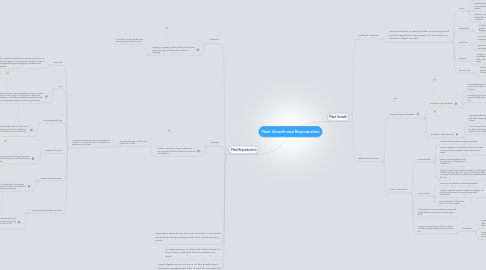
1. Plant Growth
1.1. Internal Factors
1.1.1. Internal factors in plant growth are mainly plant growth regulators, very similar to hormones in animals. These include:
1.1.1.1. Auxins
1.1.1.1.1. The most well-known one.
1.1.1.1.2. Stimulates apical growth and fruit growth while inhibiting lateral meristematic growth.
1.1.1.1.3. Present in small amounts, but as it is distributed evenly, has very noticeable effects on plants.
1.1.1.2. Gibberellins
1.1.1.2.1. Similar to auxins in that they stimulate plant growth, except these are distributed equally throughout the plant.
1.1.1.3. Cytokinins
1.1.1.3.1. Stimulate cell division and leaf mesophyll growth
1.1.1.3.2. Important in biotechnology for tissue growth stimulation.
1.1.1.4. Ethylene
1.1.1.4.1. Is largely a contributor to ripening of fruit. Stimulates the process where the fruit becomes softer and more sugary as starch is converted to sugar.
1.1.1.5. Abscisic Acid
1.1.1.5.1. Acts mainly as an inhibitor to control stomatal operations and mostly to induce dormancy to allow for survival in harsh conditions.
1.2. External Factors
1.2.1. Light Requirements
1.2.1.1. Quality of Light Received
1.2.1.1.1. Impacted by angle of incidence, shade, cloud cover, time of day and differentiations between seasons.
1.2.1.1.2. Quality of light impacts how well the plant can photosynthesize and how much it can.
1.2.1.2. Quantity of Light Received
1.2.1.2.1. Impacted by the size of the plant, competition with other, larger plants, latitude and other factors.
1.2.1.2.2. The more light the plant can receive the more it will be able to photosynthesize and the more glucose it will have at its disposal.
1.2.2. Soil Nutrients
1.2.2.1. Macronutrients
1.2.2.1.1. These must be acquired in large quantities.
1.2.2.1.2. Carbon, oxygen and hydrogen are the main ones and are acquired through carbon dioxide and water.
1.2.2.1.3. Other macronutrients include phosphorous, potassium and magnesium
1.2.2.1.4. Nitrogen is the most needed material in a plant other than water and carbon dioxide. This is obtained through nitrogen left in soil by dead matter, or nitrate ions created by bacteria in the soil.
1.2.2.2. Micronutrients
1.2.2.2.1. These are only needed in smaller quantities.
1.2.2.2.2. All play a vital role in plants, either as cofactors to make enzymes work or as part of important compounds.
1.2.2.2.3. Some examples of these are boron, zinc and copper.
1.2.2.3. Absence/lack of any nutrients will cause very serious deficiency in plants and sometimes death.
1.2.2.4. Minerals are normally eroded from rocks and other objects nearby and go into the soil.
1.2.2.4.1. Absorption
2. Plant Reproduction
2.1. Asexual
2.1.1. Budding, or growing a piece of the original plant producing a genetically identical clone as offspring
2.1.1.1. In this form of reproduction, the offspring cannot move very far
2.2. Sexual
2.2.1. Pollen is carried from flower to flower by animals and/or wind to fertilize the ovules in other flowers
2.2.1.1. The gametes fuse and the ovule grows into a seed
2.2.1.1.1. The seed are protected by many things and adapted in many ways. Not all of these are present in every case:
